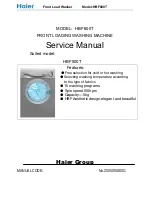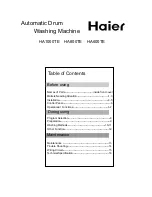
Operating instructions dishwashing machine model B-Tronic
Datei:BA_B-Tronic_MIKE_9636176_EN_2006-08.doc
Update: 2013-06-10, S. 4-13, 41
9636176
35/66
W e reserv e the right to change ex ecution and construction!
MEIKO Maschinenbau GmbH & Co. KG, Englerstraße 3, D-77652 Offenburg, Tel.: +49/781/203-0, Fax: +49/781/203-1121
9.4.2 Clean rinse water temperature
The heating capacity installed for heating the rinse water has been adjusted to suit the
quantity of rinse water.
Therefore no method of regulating the temperature has been installed as standard. The
heater has been designed to be switched on at all times.
An excess temperature cut-out has been installed as a protection against overheating.
In the case of electronically controlled appliances the excess temperature cut-out is set
using the operating display of the control system.
If the machine is not electronically controlled, the excess temperature cut-outs are set
using a separate temperature regulator (normally installed in the electrical switch cabinet).
The temperature necessary for rinsing is described in DIN 10510 and DIN 10512.
In the case of appliances heated by steam or pumped hot water (PHW), the flow rates of
the steam or hot water can also be set.
If specially requested by the client, a GPR 1 can be installed to control the flow heater.
The GPR1 circuit board provides electronic control of the temperature of the clean rinse
water when electric flow heaters (DE) are installed. This means that if the temperature of
the incoming water varies, the heat output from the flow heater is automatically regulated
so that the ideal rinse water temperature is maintained. For technical reasons the
controller is installed upstream of the excess temperature cut-out mentioned above.
A sensor monitors the actual temperature, comparing it with the temperature setting. In
the event of a deviation between these two temperatures the temperature of the rinse
water from the flow heater (DE) is brought back to the set temperature by increasing or
decreasing the length of the heating impulses.
The heating periods can be observed on the two diodes positioned above the terminals.
The control circuit is operating correctly when the diodes are almost constantly illuminated
and interrupted only by short pauses.
If the sensor cable is cut or if there is a short-circuit on the cable, the diodes will not
light up and the heater will not operate.
If the diodes are illuminated but the set temperature is not reached after a suitable
time, the heat output is too low. This can be caused by a too great volume of water or
by the excessively low temperature of the incoming water.
If the diodes are illuminated but the set temperature is exceeded, the sensor might
not be firmly fixed into position.
If the diodes are illuminated but the set temperature is exceeded, the heat output is
too great. The cause can be insufficient water; alternatively the heat output must be
reduced by 3 or 6 kW.
If the temperature of the rinse water fluctuates regularly, the heat output is too high
and the excess temperature cut-out operates constantly to prevent over-heating.
The heat output must be reduced by 3 or 6 kW or the water volume increased
accordingly.
The control circuit is defective if the diodes are constantly illuminated.
















































